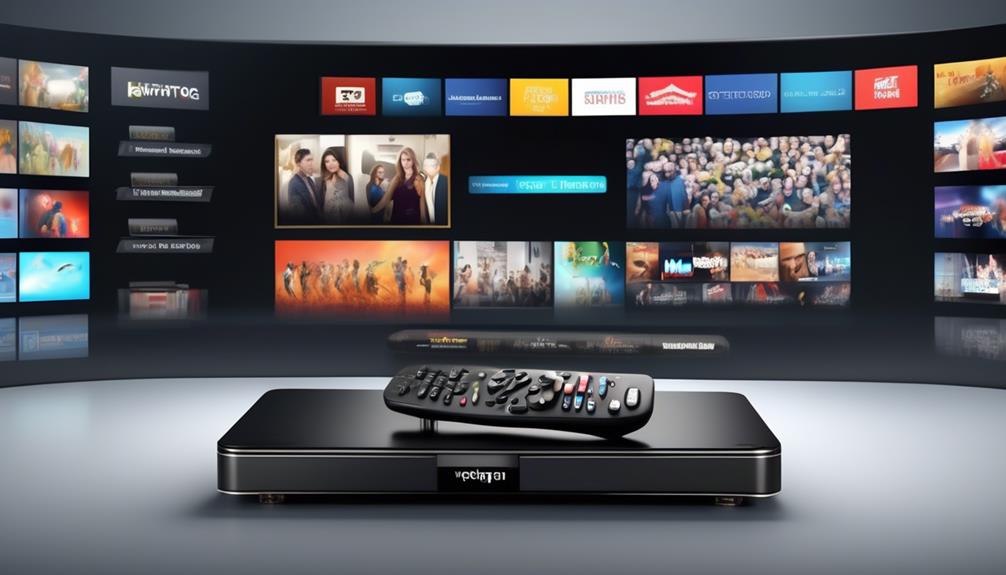So, let’s discuss the age-old argument of whether recording a show should be considered a view.
It's a question that has sparked numerous discussions among television enthusiasts and industry professionals alike.
Many of us have wondered if hitting that record button on our DVR actually contributes to a show's success.
The answer might surprise you, and it's not as straightforward as one might think.
But before we jump into the details, let's consider the impact of technology on television viewership and how it has reshaped the way we consume our favorite content.
Key Takeaways
- Recording a show on a DVR does not count as a view, unless the viewer is a voluntary participant in the Nielsen survey.
- DVR viewing is counted towards ratings if the viewer watches the commercials.
- Online viewing does not currently contribute to the traditional ratings system.
- The combination of DVR and streaming has fundamentally altered the traditional understanding of television ratings.
Television Ratings and Recording
Television ratings play a crucial role in determining the success and longevity of a show, and the impact of recording on these ratings is a topic of great significance in the television industry.
When it comes to recorded viewing, the rules are strict. Unless a viewer is a voluntary participant in the Nielsen survey, recording a show doesn't count as a view. This has significant implications for the television industry.
DVR viewing, however, is treated differently. If the viewer watches the commercials, their DVR viewing gets counted towards the ratings. This illustrates the importance of advertising revenue in the television industry. Advertisers use ratings to negotiate ad rates, and higher viewership results in higher rates. As a result, the impact of recording on ratings isn't just about audience numbers; it directly influences the financial aspects of the industry.
Interestingly, online viewing doesn't currently contribute to the traditional ratings system. Advertisers are primarily interested in viewers watching their advertisements, making online viewing irrelevant to the ratings. This creates a disparity between traditional and online viewing, highlighting the evolving nature of television programming and the challenges in accurately capturing audience engagement.
Impact of DVR and Streaming

Analyzing the impact of DVR and streaming on television ratings reveals the evolving dynamics of audience engagement and industry practices.
The advent of DVRs and streaming services has revolutionized how viewers consume content, posing a significant challenge to traditional ratings metrics.
DVRs allow viewers to record shows and watch them at their convenience, leading to delayed viewing. Nielsen's Live Plus service tracks different time frames for DVR ratings, including Live-Plus-Same-Day, Live-Plus-Three, and Live-Plus-Seven, highlighting the enduring impact of delayed viewing on ratings.
This shift has forced networks to reconsider their strategies for reporting ratings and has also prompted changes in advertising practices. The impact of DVR ratings has become an industry standard, despite privacy concerns and complaints from advertisers.
Furthermore, streaming services have further complicated the landscape, offering on-demand access to a plethora of content.
The combination of DVR and streaming has fundamentally altered the traditional understanding of television ratings, emphasizing the need for a more comprehensive approach that accounts for delayed and non-linear viewing.
Counting On-Demand Views
Counting on-demand views presents a challenge for traditional ratings metrics, as it requires a comprehensive approach to capturing non-linear viewing habits. As television programming continues to evolve, so too must the methods for measuring audience engagement.
When attempting to assess on-demand views, several key considerations come into play:
- Measurement Window: Unlike live broadcasts, on-demand views can occur days or even weeks after the initial airing. It's crucial to establish a reasonable timeframe for capturing and attributing these views accurately.
- Platform Diversity: On-demand viewing takes place across a multitude of platforms, including DVR, streaming services, and network websites. Each platform requires specific tracking mechanisms to capture viewing data effectively.
- Adapting to Changing Behaviors: As consumers increasingly turn to on-demand options, ratings systems must adapt to reflect these shifting viewing behaviors. This necessitates a recalibration of traditional metrics to encompass on-demand viewership accurately.
- Audience Engagement: Understanding the extent of viewer engagement with on-demand content is essential. Metrics shouldn't only count views but also consider factors such as completion rates and viewer interactions.
In light of these considerations, it's evident that incorporating on-demand views into ratings metrics demands a nuanced and flexible approach. Nielsen and other rating agencies are actively working to address these complexities and provide a more comprehensive representation of television viewership.
The Influence of Digital Recording

Incorporating on-demand views into ratings metrics demands a nuanced and flexible approach, and the influence of digital recording further complicates the landscape of television viewership measurement. The rise of digital recording technologies such as DVRs has revolutionized how audiences engage with television content. This shift has significant implications for how we understand and measure viewership. The advent of DVRs and on-demand streaming services has blurred the traditional boundaries of TV viewership. The table below outlines key factors influencing the influence of digital recording on television ratings.
| Factors | Influence on TV Ratings |
|---|---|
| Time-shifting nature | Challenges tracking viewership |
| Nielsen's Live Plus service | Tracks DVR ratings with different time frames |
| Advertiser concerns | Impact of DVR ratings on advertising rates |
| Data collection methods | DVR companies and sharing of viewing information |
| Future expectations | DVR ratings as an industry standard |
The influence of digital recording on television ratings is undeniable. As viewers continue to shift towards on-demand and time-shifted viewing, it is imperative for rating metrics to adapt and capture the full spectrum of audience engagement. Nielsen's Live Plus service is a step in the right direction, but ongoing innovation and flexibility are essential to accurately reflect the diverse ways audiences consume television content.
Modern TV View Metrics

With the evolving landscape of television viewership, the measurement of modern TV view metrics necessitates a dynamic and adaptable approach to capture the diverse ways audiences engage with content.
In the modern TV era, traditional live ratings no longer provide a comprehensive understanding of viewer engagement. The advent of digital recording and streaming versions has revolutionized the way people consume television, rendering the traditional live ratings insufficient for capturing the full scope of audience interaction.
The Nielsen Co. now considers metrics beyond live ratings, such as live-plus-three-days and live-plus-seven-days, to incorporate delayed viewing into the overall viewership figures.
The rise of streaming platforms has further complicated TV view metrics, as online viewing isn't currently factored into the traditional ratings system.
Advertisers, vital contributors to the TV industry, are primarily interested in viewers watching their advertisements, which makes measuring engagement beyond live viewing crucial for networks and advertisers.
As television viewing habits continue to evolve, it's imperative for the industry to develop more comprehensive metrics that account for the multitude of ways audiences consume content.
Frequently Asked Questions
How Are TV Show Views Counted?
TV show views are counted using viewership measurement tools like Nielsen ratings, which track audience engagement and viewer retention. These measures also analyze demographic data and advertising impact.
With the rise of streaming platforms, accurate data on content consumption is crucial. However, the question of whether recording a show counts as a view is complex and impacts commercial breaks.
As TV viewing habits evolve, accurate measurement methods need to adapt to ensure data accuracy.
How Long Do You Have to Watch a TV Show for It to Count as a View?
When it comes to viewer engagement and audience retention, the time intervals for measuring viewer habits can significantly impact advertiser impact and rating thresholds.
Understanding audience behavior is crucial for accurate viewer metrics and data accuracy. The evolving measurement standards reflect the changing ways we consume TV content, emphasizing the need for a comprehensive approach to capture viewer habits.
It's essential to consider these factors to ensure a complete understanding of viewer engagement and its impact on the industry.
Does Streaming Count for Ratings?
Streaming impacts Nielsen ratings and audience measurement, offering valuable insights into viewer behavior and content consumption.
Digital platforms and streaming services play a pivotal role in measuring viewer engagement, meeting advertiser expectations, and ensuring data accuracy.
As viewing habits evolve, understanding the impact of streaming on ratings is crucial for networks and advertisers to adapt their strategies and assess the true reach and influence of their content.
Does DVR Help Ratings?
DVR ratings significantly boost a show's ratings by allowing time-shifting, increasing audience engagement. Advertiser impact is a concern, as DVR viewers may skip commercials. However, DVR helps with viewer retention and impacts network competition.
Nielsen ratings measure live viewership, but DVR habits affect scheduling. Overall, DVR viewing enhances ratings measurement, offering valuable insights into viewer habits.
It's like adding a new color to a painting, enriching the TV landscape and informing programming decisions.
Conclusion
In conclusion, recording a show on a DVR doesn't count as a view in the traditional sense, but it still holds value in today's digital age. Like a hidden treasure waiting to be discovered, DVR and streaming views may not be immediately apparent, but they contribute to the overall success and impact of a show.
As technology continues to evolve, it's important for ratings systems to adapt and recognize the influence of digital recording on modern TV view metrics.










